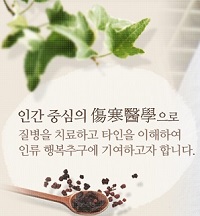『傷寒論』 辨病診斷體系에 근거하여 甘草乾薑湯 투여 후 호전된 수면 장애 관련 증례 2례
Two Case Reports of different chief complaints combined with Sleep Disorder treated by Gamchogungang-tang based on Shanghanlun Provisions
Abstract
Objective : The purpose of this study was to report the improvement in two patients with different complaints of sleep disorder treated with herbal medication based on the Shanghanlun disease pattern identification diagnostic system (DPIDS), and hypothesize the meaning of word ‘更’. Methods : According to DPIDS, patients were diagnosed with Taeyang-byung no. 29 provision, and took Gamchogungang-tang herb medication 15 or 90days. The results of administration were evaluated by the hyperhidrosis disease severity scale (HDSS) and the visual analog scale (VAS). Results : After administration of Gamchogungang-tang 15 or 90days, based on 29 provision of Gamchogungang-tang diagnosed according to Shanghanlun provisions, in one case the HDSS decreased from 3 to 1 and the VAS decreased from 10 to 1. In the other case, the VAS decreased from 10 to 1. Conclusions : Each patient not only recovered from symptoms of hyperhidrosis and alopecia areata, but also from sleep disorders following administration of a single medication of Gamchogungang-tang. This case report suggests that the word ‘更’ in the 29 provisions of Shanghanlun means sleep disorder in this case.
- keywords
- Sleep disorder, Hyperhidrosis, Alopecia areata, Gamchogungang-tang(甘草乾薑湯), Shanghanlun
참고문헌
1. Lee HR, Sleep Quality and its Associated Factors in Adults. Journal of Korean Public Health Nursing Association. 2013;27(1):76-88.
2. American Psychiatric Association, Diagnostic and Statistical Manual of Mental Disorders. DSM-5. Hakjisa. 2015:391-2.
3. American Academy of Sleep Medicine. International classification of sleep disorders, 3rd ed. Darien, IL:American Academy of Sleep Medicine. 2014.
4. Park MS, Seong NG. The Bibliographical Study of Etiology and Pathogenesis and Acupuncture Treatment of Sleep Disorder. Insomnia and Narcolepsy. Journal of Haehwa Medicine. 1998;6(2):483-501.
5. Jeong JH, Ha JW, Kim BK. The Current Status about Sleep Disorder in the Journal of Oriental Neuropsychiatry for Evidence Based Medicine. Journal of oriental neuropsychiatry. 2012;23(4):11-36.
6. Lim JE, Lee SJ. A diagnostic system and clinical application based on <Shanghanlun>six meridian patterns and provisions. Seoul:KMediACs publishing house. 2013;5(1):1-17.
7. Rho YB, Lee JH, Ha HI. The Fundamental Meaning of Mai and Shanghanlun Provisions Based on Paleography. Seoul:KMediACs publishing house. 2015;7(1):1-14.
8. Shin YJ, Kim YH, Yang HJ, Lee JW. Review of the Clinical Evaluation of Hyperhidrosis. Korean Journal of Orient.Int. Med. 2015:143-56.
9. Lee SI, Cho HR. The comparison of the Shanghanlun. Seoul:KMediACS publisihing house. 2015:206.
10. Jeong SY, Kim JY, Kho YT, Ahn KS, Lee CR. Oriental Medical Treatment Pattern of Korean Patients with Sleep Disorders. Journal of oriental neuropsychiatry. 2014;25(4):389-400.
11. Kim SU, Jeong HJ. A Study on Treatment of Sleep Disturbance in the Books on Cold Damage. The journal of Korean medical history. 2014;27(2):99-120.
12. Oh JH, Kim BS, Lim HY, Kim DW, Choi BH, Kim DJ, Jun YI, Cho CK, Byun JS. A Case of Stroke Patient Who Showed Improvement in Constipation, Chest Discomfort and Insomnia tyrough Treatment of Daeseungkitang(大承氣湯). The journal of internal Korean medicine. 2004;25(2):307-13.
13. Choi SH, Kim JM, Chang MW, Moon SH, Jo HK, Seol IC. A Case of Cerebral Infarction Patient Accompanied by Chest discomfort, Insomnia and Constipation Treated with Daehwanghwangryeonsasim-tang. Journal of the Korea institute of oriental medical informatics. 2009;15(2):93-9.
14. Kim JA, Jo GM, Lee SJ. Analyzing etiologic factors of Cases:Understanding Sanghanlun record of anger and sleeping disorder. Journal of Korean Medical Association of Clinical Sanghan-Geum-gwe. 2015;7(1):87-106.
15. Lee LC, Min JH. A Case Report of Overactive Bladder treated by Gamchogungang-tang, Hoiyeok-tang based on Shanghanlun provisions. Journal of Korean Medical Association of Clinical Sanghan-Geum-gwe. 2013;5(1):45-52.
16. Song IS. A Study on the clinical effects of gamcho-gungang-tang. Kyungsung university Graduate School of Clinical Pharmacy and Health:Master’s dissertation. 2000.
17. http://www.doopedia.co.k, “更”, http://www.doopedia.co.kr/doopedia/master/master.do?_method=view&MAS_IDX=101013000826266
- 다운로드 수
- 조회수
- 0KCI 피인용수
- 0WOS 피인용수


